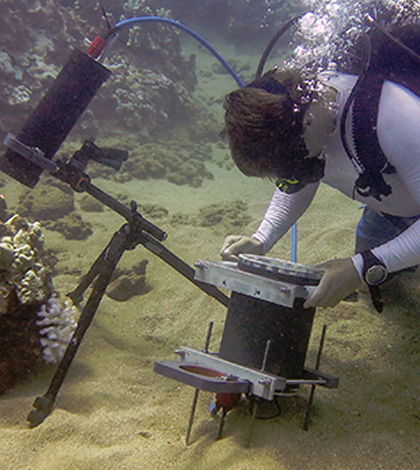New Benthic Underwater Microscope Captures Coral Wars

Andrew Mullen, graduate student at Scripps Institution of Oceanography, positions the Benthic Underwater Microscope to study coral competition. (Credit: University of California - San Diego / Scripps Institution of Oceanography)
Researchers from Scripps Institution of Oceanography at the University of California – San Diego have designed and built a diver-operated underwater microscope to study millimeter-scale processes as they naturally occur on the seafloor. The research team has observed coral turf wars, coral polyp “kissing” and much more using the new microscopic technology.
Many important biological processes in the ocean take place at microscopic scales, but when scientists remove organisms from their native habitats to study them in the lab, much of the information and its context are lost. In a quest to overcome this challenge, Scripps oceanographers developed the new type of underwater microscope to image marine microorganisms in their natural settings without disturbing them.
The Benthic Underwater Microscope, or BUM, is a two-part system — an underwater computer with a diver interface tethered to a microscopic imaging unit — to study marine subjects at nearly micron resolution. The instrument has a high-magnification lens, a ring of focused LED lights for fast exposures, fluorescence imaging capabilities and a flexible tunable lens, similar to the human eye, to change focus for viewing structures in three dimensions.
The motivation for building the imaging system was to better understand the many ecological processes taking place underwater at microscopic scales. To test the new technology’s ability to capture small-scale processes taking place underwater, researchers have used the imaging system to view millimeter-sized coral polyps off the coast of Israel in the Red Sea and other places.
The images revealed micro-scale processes in which corals emit string-like filaments that secrete enzymes from their stomach cavity to wage a chemical turf battle to destroy the tissue of other species in competition for seafloor space. But when the researchers placed corals of the same species next to one another, they did not eject the same gastric fluids.
An article discussing the Benthic Underwater Microscope is published in the journal Nature Communications.
Top image: Andrew Mullen, graduate student at Scripps Institution of Oceanography, positions the Benthic Underwater Microscope to study coral competition. (Credit: University of California – San Diego / Scripps Institution of Oceanography)




0 comments